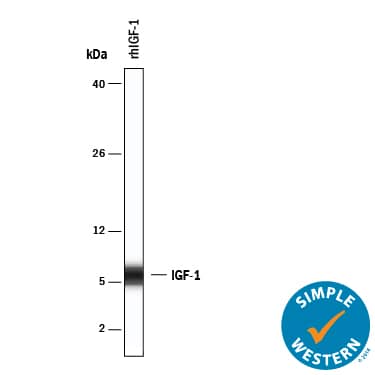Human IGF-I/IGF-1 Biotinylated Antibody
R&D Systems, part of Bio-Techne | Catalog # BAF291


Key Product Details
Species Reactivity
Validated:
Cited:
Applications
Validated:
Cited:
Label
Antibody Source
Product Specifications
Immunogen
Specificity
Clonality
Host
Isotype
Scientific Data Images for Human IGF-I/IGF-1 Biotinylated Antibody
Detection of Human IGF-I/IGF-1 by Simple WesternTM.
Simple Western lane view shows lysates of Recombinant Human IGF-1, loaded at 0.2 mg/mL. A specific band was detected for IGF-I/IGF-1 at approximately 6 kDa (as indicated) using 50 µg/mL of Goat Anti-Human IGF-I/IGF-1 Biotinylated Antigen Affinity-purified Polyclonal Antibody (Catalog # BAF291) . This experiment was conducted under reducing conditions and using the 2-40kDa separation system.Applications for Human IGF-I/IGF-1 Biotinylated Antibody
Simple Western
Sample: Recombinant Human IGF-1
Western Blot
Sample: Recombinant Human IGF-I/IGF-1 (Catalog # 291-G1)
Human IGF-I/IGF-1 Sandwich Immunoassay
Formulation, Preparation, and Storage
Purification
Reconstitution
Formulation
Shipping
Stability & Storage
- 12 months from date of receipt, -20 to -70 °C as supplied.
- 1 month, 2 to 8 °C under sterile conditions after reconstitution.
- 6 months, -20 to -70 °C under sterile conditions after reconstitution.
Background: IGF-I/IGF-1
Insulin-like growth factor I, also known as somatomedin C, is the dominant effector of growth hormone and is structurally homologous to proinsulin. Human IGF-I/IGF-1 is synthesized as two precursor isoforms with N- and alternate C-terminal propeptides (1). These isoforms are differentially expressed by various tissues (1). The 7.6 kDa mature IGF-I/IGF-1 is identical between isoforms and is generated by proteolytic removal of the N- and C-terminal regions. Mature human IGF-I/IGF-1 shares 94% and 96% aa sequence identity with mouse and rat IGF-I/IGF-1, respectively (2), and exhibits cross-species activity. It shares 64% aa sequence identity with mature human IGF-II/IGF-2. Circulating IGF-I/IGF-1 is produced by hepatocytes, while local IGF-I/IGF-1 is produced by many other tissues in which it has paracrine effects (1). IGF-I/IGF-1 induces the proliferation, migration, and differentiation of a wide variety of cell types during development and postnatally (3). IGF-I/IGF-1 regulates glucose and fatty acid metabolism, steroid hormone activity, and cartilage and bone metabolism (4 - 7). It plays an important role in muscle regeneration and tumor progression (1, 8). IGF-I binds IGF-I R, IGF-II R, and the insulin receptor, although its effects are mediated primarily by IGF-I R (9). IGF-I/IGF-1 association with IGF binding proteins increases its plasma half-life and modulates its interactions with receptors (10).
References
- Philippou, A. et al. (2007) In Vivo 21:45.
- Sandberg-Nordqvist, A.C. et al. (1992) Brain Res. Mol. Brain Res. 12:275.
- Guvakova, M.A. (2007) Int. J. Biochem. Cell Biol. 39:890.
- Clemmons, D.R. (2006) Curr. Opin. Pharmacol. 6:620.
- Bluher, S. et al. (2005) Best Pract. Res. Clin. Endocrinol. Metab. 19:577.
- Garcia-Segura, L.M. et al. (2006) Neuroendocrinology 84:275.
- Malemud, C.J. (2007) Clin. Chim. Acta 375:10.
- Samani, A.A. et al. (2007) Endocrine Rev. 28:20.
- LeRoith, D. and S. Yakar (2007) Nat. Clin. Pract. Endocrinol. Metab. 3:302.
- Denley, A. et al. (2005) Cytokine Growth Factor Rev. 16:421.
Long Name
Alternate Names
Gene Symbol
Additional IGF-I/IGF-1 Products
Product Documents for Human IGF-I/IGF-1 Biotinylated Antibody
Product Specific Notices for Human IGF-I/IGF-1 Biotinylated Antibody
For research use only